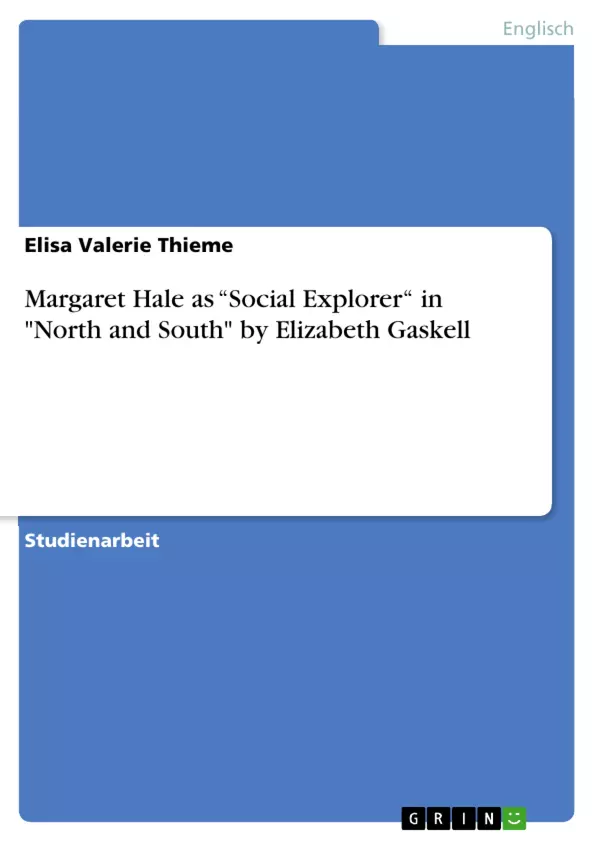The condition of the lower classes under the effects of industrialisation is one of the most frequently depicted topics in literary works about nineteenth century England. Elizabeth Gaskell is one of the more prominent novelists who wrote about such conditions by drawing the reader’s attention to the social injustices of her time.
The increased level of literacy in Victorian England contributed to a mass-market for book publishing and its mass audience was mainly made up of middle-class readers. Their attitude towards the poor, the “Other Nation”, was fundamentally that of horror and fear of rebellion, the contagion of diseases, disgust and sometimes even pity. They were able to read about the lower classes from a secure distance and either be admonished of the ‘danger’ that they represented or share the writer’s sympathy.
Elizabeth Gaskell was deeply concerned with the social situation of her time and expressed her attitude towards the social system and the neglected by means of her novels. She used her writing as an instrument of social criticism and to express her overt attitude toward the widespread distress. In order to change the indifference of her target audience mentioned above, she employed the figure of a social explorer. To evoke the reader’s sympathy through pity, she utilised individuals to represent society. This paper concerns with one of her social explorers: the middle class heroine Margaret Hale who was brought up in the South but is forced to leave her home and move to an industrial town in the North.
Inhaltsverzeichnis
- Introduction
- Social Conditions of the Lower Classes in Nineteenth Century England
- Margaret Hale as a social explorer
- Definition of a social explorer and how Margaret Hale could be considered as one
- Margaret Hale's insights and observations in detail
- Conclusion
Zielsetzung und Themenschwerpunkte
Diese Arbeit analysiert die Figur von Margaret Hale in Elizabeth Gaskells Roman „North and South“ als soziale Erforscherin. Der Fokus liegt auf der Darstellung der sozialen Bedingungen der Arbeiterklasse im England des 19. Jahrhunderts und wie Margaret Hale diese durch ihre eigene Reise und Beobachtungen beleuchtet.
- Die sozialen Bedingungen der Arbeiterklasse im England des 19. Jahrhunderts unter dem Einfluss der Industrialisierung
- Die Rolle von Margaret Hale als soziale Erforscherin und ihre Perspektive auf die soziale Ungleichheit
- Die Bedeutung von Gaskells Roman als sozialkritisches Werk und seine Intention, die Leser für die sozialen Missstände zu sensibilisieren
- Die Darstellung der Charaktere und ihre Interaktion im Kontext der sozialen und wirtschaftlichen Konflikte
- Die Einbettung des Romans in den historischen Kontext der sozialen und politischen Veränderungen des 19. Jahrhunderts
Zusammenfassung der Kapitel
Die Einleitung führt in das Thema der sozialen Bedingungen der Arbeiterklasse im England des 19. Jahrhunderts ein und stellt Elizabeth Gaskell als eine prominente Autorin vor, die sich mit diesen Themen auseinandersetzte. Das zweite Kapitel beleuchtet die sozialen Bedingungen der Arbeiterklasse im Kontext der Industrialisierung, wobei die negativen Auswirkungen der Industrialisierung auf die Lebensbedingungen der Menschen im Vordergrund stehen. Das dritte Kapitel widmet sich Margaret Hale als sozialer Erforscherin und analysiert ihre Rolle als Beobachterin der sozialen Verhältnisse und ihre persönlichen Erfahrungen im Umgang mit den sozialen Ungleichheiten der Zeit.
Schlüsselwörter
Die Arbeit beschäftigt sich mit den Themen der sozialen Ungleichheit, der Industrialisierung, der Arbeiterklasse, der sozialen Erforschung, der viktorianischen Literatur, Elizabeth Gaskell und „North and South“. Weitere wichtige Begriffe sind soziale Bedingungen, soziale Probleme, Klassenkonflikt und die Rolle des Romans als Instrument der sozialen Kritik.
- Quote paper
- B.A. Elisa Valerie Thieme (Author), 2010, Margaret Hale as “Social Explorer“ in "North and South" by Elizabeth Gaskell, Munich, GRIN Verlag, https://www.grin.com/document/283214



